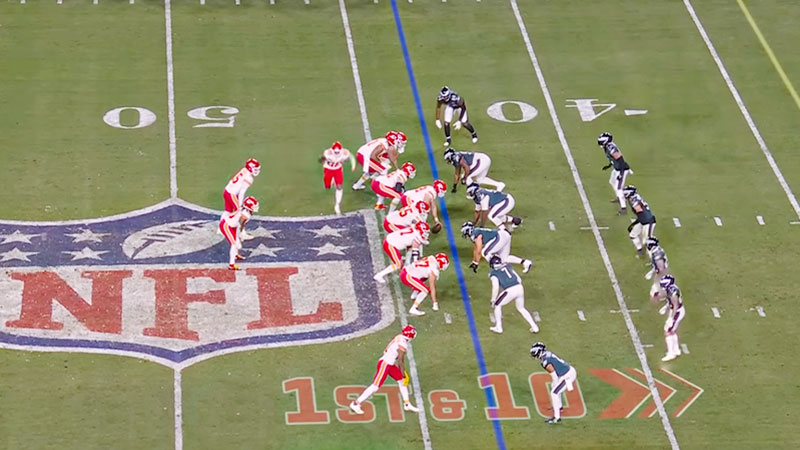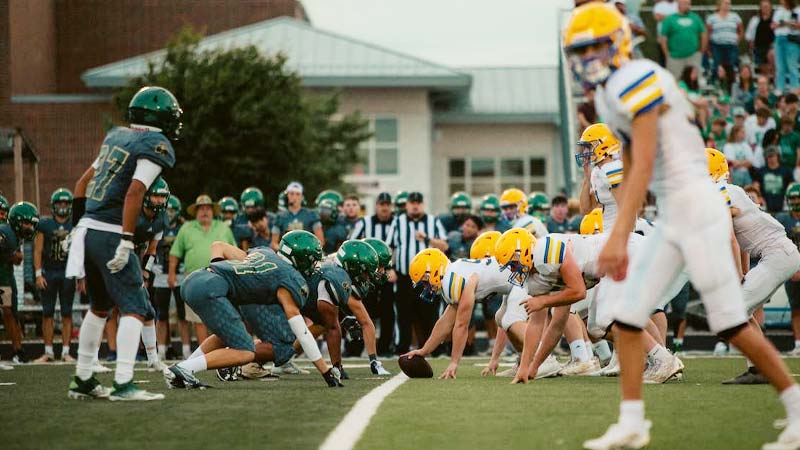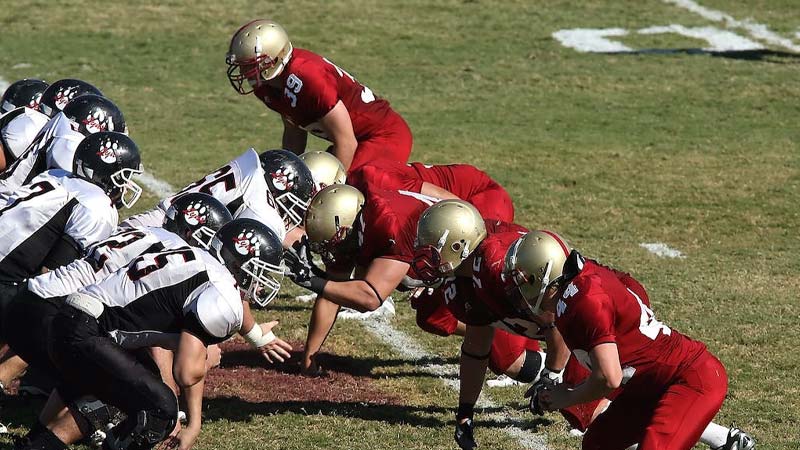Defensive strategies play a pivotal role in American football, dictating the outcome of games and separating the champions from the rest.
Among the various defensive formations, the Football 5-4 Defense stands out as a formidable approach, offering a balanced blend of run-stopping power and pass-rushing prowess.
In this comprehensive guide, we delve into the world of the 5-4 Defense, unraveling its secrets, strengths, and limitations. Whether you’re a player, coach, or avid football enthusiast, join us on this journey to understand the ins and outs of this intriguing formation. Stay focused.
What is Football 5-4 Defense?
The Football 5-4 Defense is a defensive formation commonly used in American football. It is a variation of the 5-2 defense, with five defensive linemen and four linebackers. This formation aims to stop both the running and passing plays effectively.
The five defensive linemen line up across the line of scrimmage, responsible for disrupting the offensive line and pressuring the quarterback. The four linebackers are positioned behind the linemen, covering gaps and supporting against both the run and the pass.
This defense is suitable for countering balanced offenses and can adjust to different offensive formations. Its focus on a strong front and adequate linebacker support makes it versatile and challenging for opponents to exploit.
Responsibilities of Football 5-4 Defense

The Football 5-4 Defense comes with specific responsibilities for each player on the field:
Defensive Linemen
The five defensive linemen are responsible for the initial line of defense. Their primary objectives are to disrupt the offensive line, control their assigned gaps, and put pressure on the quarterback.
They must be adept at shedding blockers, maintaining gap integrity, and creating chaos in the backfield to disrupt running plays and force hurried passes.
Linebackers
The four linebackers play a crucial role in both run defense and pass coverage. They are responsible for filling gaps in the defensive line to stop running backs and must be skilled tacklers.
Additionally, they need to drop into pass coverage to defend against short and intermediate passes, covering tight ends, running backs, and occasionally wide receivers.
Secondary
The secondary players, including cornerbacks and safeties, have the responsibility of defending against long passes and providing additional support in run defense.
They need to maintain tight coverage on wide receivers, break up passes, and help prevent big plays. Safeties are also crucial in run support, providing an extra layer of defense against potential breakaway runs.
Communication
All players in the 5-4 Defense must communicate effectively with each other, making pre-snap adjustments based on the offensive formation and recognizing any potential threats.
Clear and concise communication is vital for executing the defensive game plan efficiently and avoiding breakdowns in coverage.
Practice the Strategies of 5-4 Defense

Practicing the strategies of the 5-4 Defense involves several key aspects, including individual player skills, teamwork, communication, and understanding of defensive concepts. Here are some specific practice drills and strategies to implement:
Gap Control Drill
Set up cones or markers representing different gaps along the defensive line. Have the defensive linemen practice quickly getting into their assigned gaps, maintaining leverage, and shedding blocks to stop imaginary running plays. Emphasize proper footwork and hand placement.
Blitz Packages
Work on specific blitz packages involving linebackers and defensive backs. Practice different blitz angles and timing to pressure the quarterback effectively. Ensure that linebackers and defensive backs know their responsibilities when blitzing and maintain discipline to avoid leaving gaps open.
Pass Coverage Drills
Focus on individual and group pass coverage drills for linebackers and defensive backs. Work on backpedaling, maintaining proper positioning, and recognizing route patterns to improve coverage skills.
Run Defense Simulation
Set up full-team scenarios where the defense faces various offensive formations and run plays. Emphasize gap discipline and teach players to work together to stop the run effectively.
Zone Coverage Concepts
Practice zone coverage principles with the linebackers and defensive backs. Teach them to work in unison, read the quarterback’s eyes, and react to potential threats in their assigned zones.
Man-to-Man Coverage Repetitions
Practice one-on-one coverage situations, simulating different receiver types (e.g., wide receivers, tight ends, running backs). Teach defensive backs to use proper techniques such as jamming at the line of scrimmage and mirroring the receiver’s movements.
Communication Exercises
Implement drills that focus on communication between players, particularly during pre-snap adjustments. Teach players to recognize offensive formations quickly and make necessary calls to adjust the defense accordingly.
Film Study
Regularly review game and practice footage with the players to analyze their performance, identify areas for improvement, and reinforce key defensive concepts.
Scrimmages and Game Simulations
Organize intra-squad scrimmages and game simulations to apply the 5-4 Defense in live situations. This allows players to experience real-game scenarios and enhances their ability to react under pressure.
Evaluate and Adjust
Continuously assess the effectiveness of the 5-4 Defense during practices and games. Make adjustments to the defensive game plan based on the strengths and weaknesses of the team and the upcoming opponents.
Remember, consistent practice, attention to detail, and teamwork are crucial for mastering the strategies of the 5-4 Defense.
Advantages of 5-4 Defense

The 5-4 Defense offers several advantages that can make it an effective strategy in American football:
Strong Run Defense
With five defensive linemen and four linebackers, the 5-4 Defense provides a stout front against the run. The extra linemen and linebackers help clog running lanes, fill gaps effectively, and make it challenging for opposing running backs to find open space.
Gap Control
The alignment of the defensive linemen and linebackers allows for better gap control, reducing the likelihood of big running plays and forcing runners to bounce to the outside, where the defense can pursue.
Pass Rushing
The presence of five defensive linemen enables better pass-rushing capabilities. The defense can apply pressure on the quarterback with fewer blitzes, allowing the linebackers and defensive backs to focus on coverage.
Flexibility
The 5-4 Defense can adjust to different offensive formations, making it versatile against both traditional run-heavy offenses and modern pass-oriented attacks. It can effectively handle spread offenses by adjusting the alignment and positioning of players.
Pass Coverage
The four linebackers provide additional support in pass coverage. They can cover short to intermediate routes effectively, reducing the risk of giving up big plays over the middle of the field.
Blitzing Options
Despite having four linebackers, the 5-4 Defense still allows for creative blitzing packages. The defense can send extra pass rushers from different angles, confusing the offensive line and quarterback
Control Time of Possession
By stifling the running game and limiting big plays, the 5-4 Defense can help the offense control the time of possession. This keeps the defense well-rested and the opposing offense off the field.
Stopping Power in Short Yardage
The 5-4 Defense excels in short-yardage situations, where stopping the run is crucial. The formation’s strong front can prevent the offense from gaining the necessary yardage on critical downs.
Pressure on Opposing Offenses
The 5-4 Defense puts pressure on the opposing offense to adjust their game plan and execute precisely. The threat of a strong pass rush and disciplined run defense can force the offense into mistakes and turnovers.
Limiting Big Plays
The combination of a disciplined front and sound coverage can reduce the number of big plays allowed by the defense. This helps keep games competitive and prevents quick momentum swings in favor of the opponent.
Disadvantages of 5-4 Defense

While the 5-4 Defense offers several advantages, it also comes with some inherent disadvantages that coaches and players should consider:
Vulnerability to the Pass
The 5-4 Defense may be more susceptible to the passing game, especially against teams with strong quarterback play and talented receiving corps. With fewer defensive backs in coverage, opponents can exploit the intermediate and deep areas of the field.
Exposure to Play-Action
The aggressive nature of the 5-4 Defense can leave it vulnerable to play-action passes. The commitment to stopping the run might cause linebackers to bite on play fakes, creating openings for receivers downfield.
Limited Coverage against Spread Offenses
Against spread offenses with multiple receivers, the 5-4 Defense might struggle to match up adequately in pass coverage. This formation could be challenged by offenses that can quickly spread the field and find mismatches.
Blitzing Risks
While the 5-4 Defense allows for creative blitz packages, sending additional pass rushers can leave the defense exposed in the secondary. If the blitz is not effective, it can lead to significant gains for the offense.
Gap Vulnerabilities
Despite its emphasis on gap control, the 5-4 Defense can be exploited by skilled running backs who can find cutback lanes or exploit small gaps between defenders.
Personnel Requirements
The 5-4 Defense may require specific personnel with the right combination of size, speed, and versatility to be effective. Teams with limited depth or players not suited for this formation may struggle to implement it successfully.
Run Defense Stretched Wide
Defending the outside run can be challenging with only four linebackers, as they need to cover a broader area, leaving potential gaps in the perimeter defense.
Fatigue
The extra burden placed on the defensive linemen and linebackers to stop the run and generate a pass rush can lead to fatigue late in games. This could impact their effectiveness as the game progresses.
To address these disadvantages, coaches must carefully game-plan and adjust their defensive strategies based on the strengths and weaknesses of their personnel and the specific opponents they face.
FAQs
What is the Football 5-4 Defense, and how does it work?
The Football 5-4 Defense is a defensive formation featuring five linemen and four linebackers. Its primary objective is to stop both the run and pass effectively.
The defensive linemen disrupt the offensive line, while the linebackers provide support against the run and pass, creating a formidable defensive front.
What are the advantages of the 5-4 Defense?
The 5-4 Defense boasts strengths such as strong run defense, effective gap control, versatile blitzing options, and the ability to adjust to different offensive formations. It also limits big plays and keeps the opposing offense off-balance.
What are the disadvantages of the 5-4 Defense?
While effective against the run, the 5-4 Defense can be vulnerable to the pass, especially against teams with talented quarterbacks and receiving units. It may also struggle against spread offenses and leaves the secondary exposed when blitzing.
How can teams practice and implement the 5-4 Defense successfully?
Teams can practice the 5-4 Defense through gap control drills, blitz packages, pass coverage drills, and game simulations. Communication and teamwork are vital for executing this formation effectively.
When is the 5-4 Defense an ideal choice for a team?
The 5-4 Defense is an excellent choice against balanced offenses and in short-yardage situations. It can be particularly effective when a team has the right personnel to execute the formation’s responsibilities effectively.
Wrapping Up
The Football 5-4 Defense has earned its place as a staple in the arsenal of many football teams. With its ability to stop the run, pressure the quarterback, and adjust to various offensive schemes, this defensive formation demands respect and careful consideration from opponents.
As you dive into the intricacies of the 5-4 Defense, keep in mind its advantages and disadvantages, as well as the key elements that contribute to mastering this potent strategy.
Armed with knowledge and diligent practice, your team can make a formidable impact on the gridiron, outmaneuvering the competition and securing victory in the face of any challenge. Thank you for your effort.







